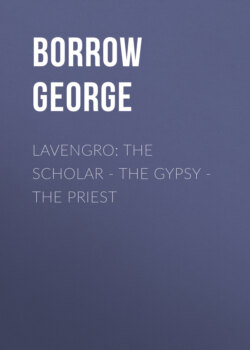Читать книгу Lavengro: the Scholar - the Gypsy - the Priest - Borrow George - Страница 6
На сайте Литреса книга снята с продажи.
IV. Borrow’s Use of Patois.
ОглавлениеTable of Contents
Nor does Borrow take much trouble to give organic life to a dramatic picture by the aid of patois in dialogue. In every conversation between Borrow’s gypsies, and between them and Lavengro, the illusion is constantly being disturbed by the vocabulary of the speakers. It is hard for the reader to believe that characters such as Jasper Petulengro, his wife, and sister Ursula, between whom so much of the dialogue is distributed, should make use of the complex sentences and book-words which Borrow, on occasion, puts into their mouths.
I remember once remarking to him upon the value of patois within certain limits—not only in imaginative but in biographic art.
His answer came in substance to this, that if the matter of the dialogue be true to nature, the entire verisimilitude of the form is a secondary consideration.
“Walter Scott,” said he, “has run to death the method of patois dialogue.”
He urged, moreover, that the gypsies really are extremely fond of uncommon and fine words. And this, no doubt, is true, especially in regard to the women. There is nothing in which the native superiority of the illiterate Romany woman over the illiterate English woman of the road is more clearly seen than in the love of long “book-words” (often mispronounced) displayed by the former. Strong, however, as is the Romany chi’s passion for fine words, her sentences are rarely complex like some of the sentences Borrow puts into her mouth.
With regard, however, to the charge of idealising gypsy life—a charge which has often been brought against Borrow—it must be remembered that the gypsies to whom he introduces us are the better kind of gryengroes (horse-dealers), by far the most prosperous of all gypsies. Borrow’s “gryengroes” are not in any way more prosperous than those he knew.
These nomads have an instinctive knowledge of horseflesh—will tell the amount of “blood” in any horse by a lightning glance at his quarters—and will sometimes make large sums before the fair is over.
Yet, on the whole, I will not deny that Borrow was as successful in giving us vital portraits of English and Irish characters as of Romany characters, perhaps more so.
That hypochondriacal strain in Borrow’s nature, which Dr. Hake alludes to, perhaps prevented him from sympathising fully with the joyous Romany temper. But over and above this, and charming as the Petulengro family are, they do not live as do the characters of Mr. Groome in his delightful book “In Gypsy Tents”—a writer whose treatises on the gypsies in the “Encyclopædia Britannica,” and in “Chambers’ Encyclopedia,” are as full of the fruits of actual personal contact with the gypsies as of the learning to be derived from books.
